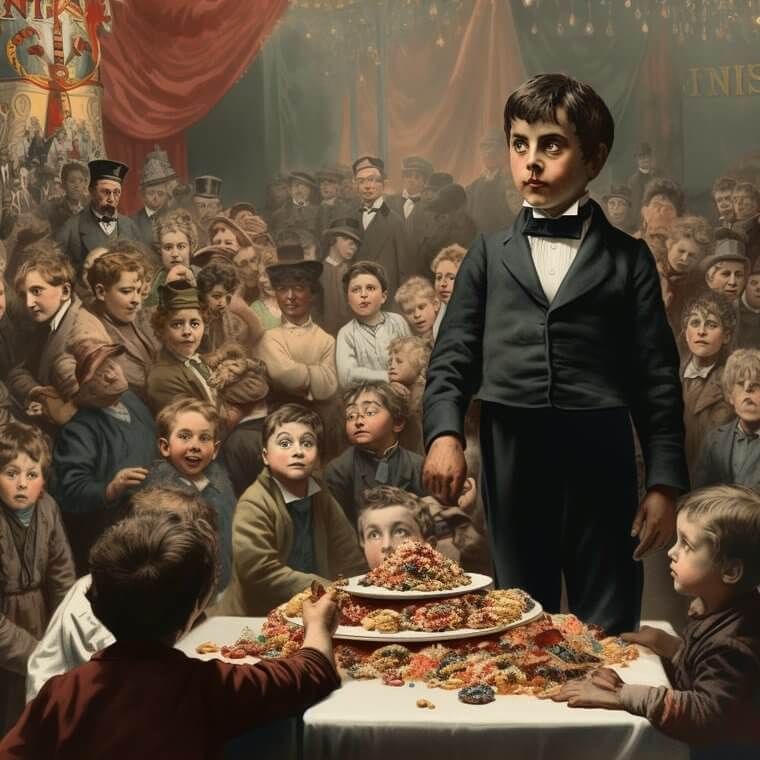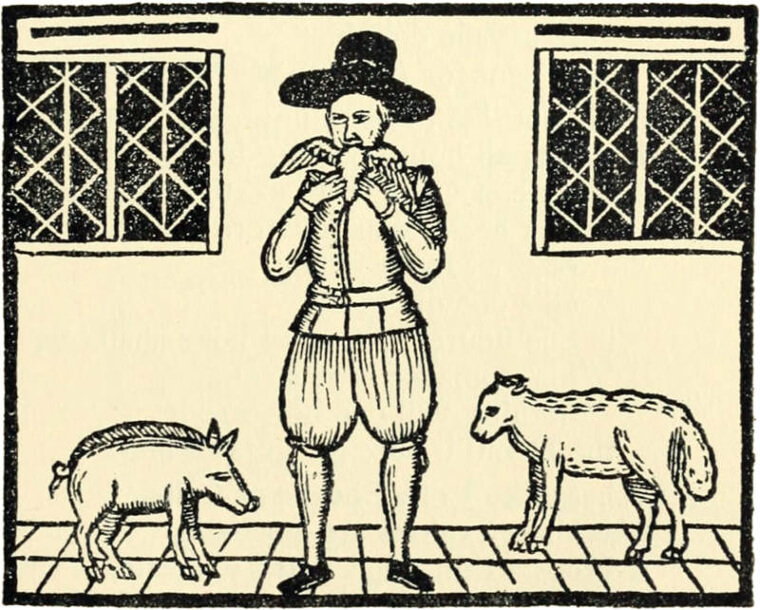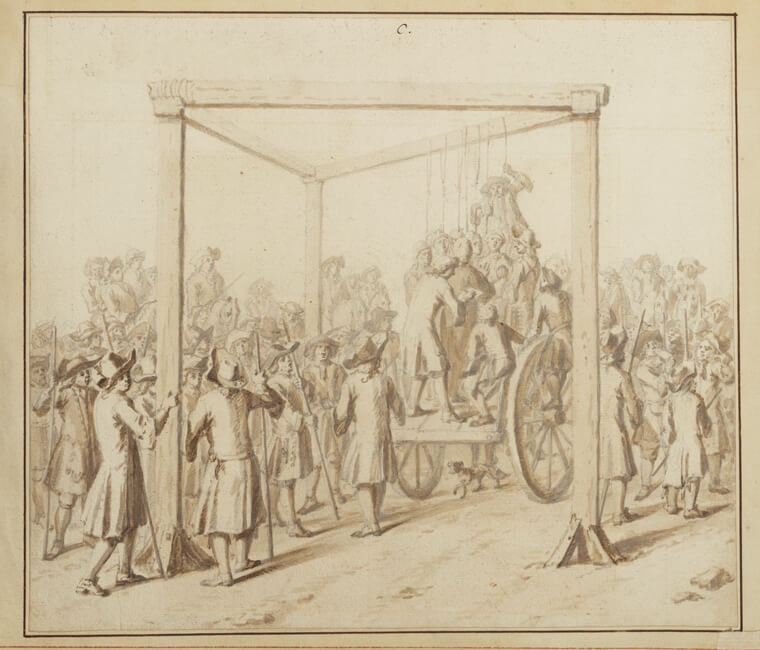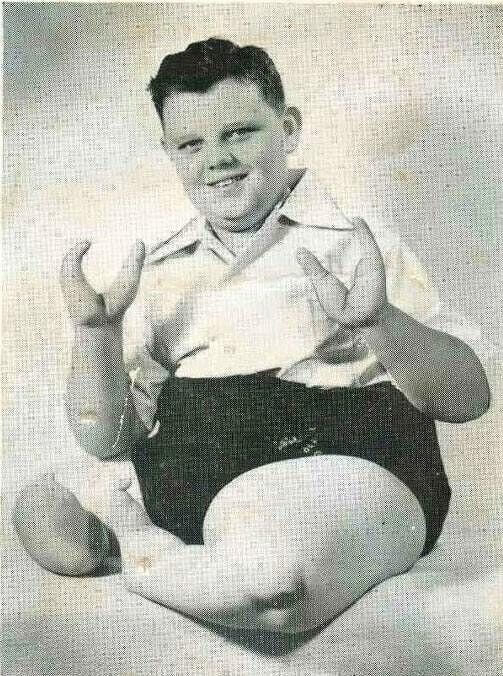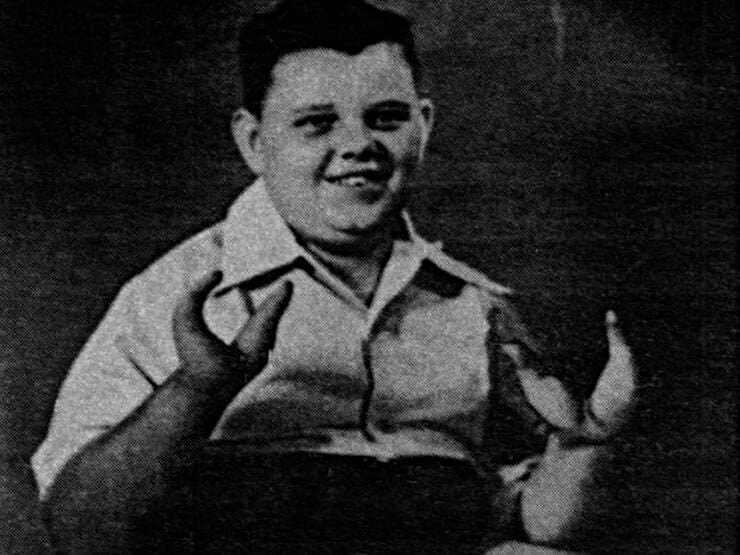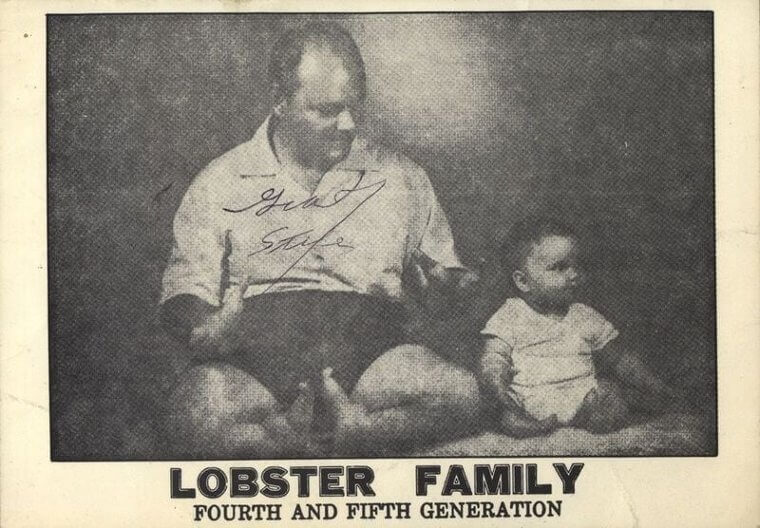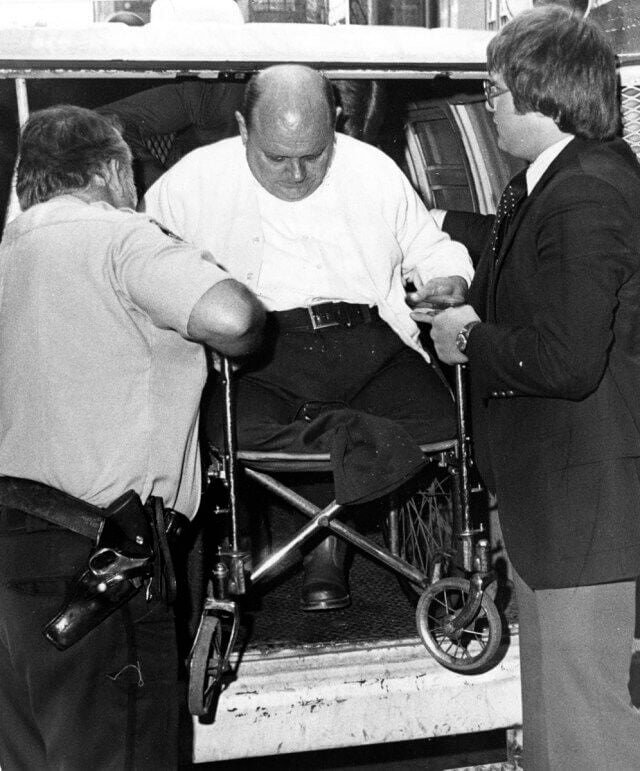The story of Tarrare is definitely one of a kind. This man had a unique 'gift' - he had a huge appetite. Tarrare was always hungry and able to eat an unfathomable amount of food. His entire body seemed to be designed for just one purpose - eating. Tarrare's story involves show business, war, espionage, medical experiments, and - most shockingly - a mysteriously missing baby. We're warning you—this story is not for the squeamish.
Hungry Child
Born in Lyon, France, around 1772, Tarrare was an unusual child from the very beginning. He was always hungry, no matter how much his parents fed him. By the time he was a teenager, he ate his own body weight in beef in a single day. To put that into context, the average human needs to consume around 5% of their own mass each day.
Little is known about the background of Tarrare, or even if Tarrare was his real name, but it seems clear that keeping their insatiable child fed was a financial burden his parents were unable to endure. Sometime before his 16th birthday, Tarrare’s mom and dad were left with no option but to turn him out and force him to fend for himself.
Traveling Performer
After being kicked out, Tarrare joined a nomadic band of bandits and sex workers. He drifted from place to place, begging for food when he could, stealing when he needed. After a while, he joined a group that purported to be a traveling circus. They would perform “freak show” style acts in order to draw and distract crowds for easy pickpocketing. Tarrare's act was unseen before.
Tarrare’s job was to do what he did best - eat. He would stretch his jaw to devour baskets of apples as though they were bags of nuts. He also ate objects such as corks or stones. It seemed there was nothing Tarrare could not ingest and the crowds in every place they visited lapped up the spectacle of his gluttony.
Extreme Carnivore
Inanimate objects and fruit weren’t the only things Tarrare would eat to excess, he also picked up a habit of consuming live animals. “He seized a live cat with his teeth, eventrated [or disemboweled] it, sucked its blood, and ate it, leaving the bare skeleton only,” said one witness to Tarrare’s increasingly disturbing stage act.
“He also ate dogs in the same manner. On one occasion it was said that he swallowed a living eel without chewing it.” Snake meat was a particular favorite of Tarrare's. His reputation was so gruesome that it seemed even the animals knew to keep out of his way. “The dogs and cats fled in terror at his aspect,” wrote the military surgeon Baron Percy, “as if they had anticipated the kind of fate he was preparing for them.”
Close Call
In 1788, in his late teens, Tarrere swapped countryside wanderings for regular performances in Paris. There, among the grand boulevards and wealthy citizens, the rapacious young man found a way to fill his pockets, even if he couldn’t fill his belly. But. one day during his usual wolfish performance, he had a sudden and severe intestinal obstruction.
Tarrare was saved after onlookers took him to the Hôtel-Dieu hospital, where he was administered strong laxatives. When he recovered, Tarrare offered to eat the surgeon’s watch and chain as a sort of performative “merci”. The surgeon, M. Giraud, refused and warned him that he had the tools to cut the irrepressible eater open and would not hesitate to do whatever was necessary to get his stuff back.
Loose Skin
What was especially puzzling for anyone who saw Tarrare, was his appearance. Despite his constant and excessive eating, at 17 years old he weighed no more than 100 pounds. He also seemed to be mentally competent in every way, aside from eating anything he could get his hands on. The main physical sign of Tarrare’s bizarre lifestyle was his stretched and sagging skin.
The constantly famished Frenchman had a regular process which went as follows. First, he would eat until he was bloated, like an inflated balloon. Then, he would find a bathroom and create a situation that was once described as “fetid beyond all conception.” This would leave him empty once again so the routine could be repeated. As a result, Tarrare’s skin, from his head to his waist, hung down in huge folds whenever his body was not filled.
Sensory Side Effects
Another unpleasant physical aspect of Tarrare’s eating was often noticed before he even came into view. According to his official medical notes, Tarrare “often stank to such a degree that he could not be endured within the distance of twenty paces.” It was observed the Frenchman’s odor became significantly worse in the time immediately following a feast.
Tarrare was described as having red cheeks, bloodshot eyes, and a vapor that could be seen visibly rising from his body, like stink lines in a comic book. Other descriptions of Tarrare suggest his hair was surprisingly soft while his mouth was, unsurprisingly, large. His teeth were discolored and his lips were so thin as to be almost unnoticeable. The skin on his stomach, when at its most loose, could be tied around his waist like a belt.
Meager Rations
When Tarrare was around 19 years old, the War of the First Coalition broke out and France found itself under fire. Keen to stand up for his country, Tarrare gave up his performances and joined the French Revolutionary Army. However, Tarrare quickly found it hard to survive on soldiers’ rations of food. He performed odd jobs in exchange for shares of his comrades' food, but it didn't satisfy Terrare's needs.
He began scavenging for scraps in the waste but eventually had to be hospitalized for extreme exhaustion. During his recovery, the army quadrupled Tarrare’s rations, but it still wasn’t enough. He searched through the gutters and garbage piles. He ate whatever was left behind by other patients. He even snuck into the apothecary's room to eat the poultices. After this, the military surgeons couldn’t contain their curiosity any longer.
Hospital Experiment
Rather than discharge Tarrare, the surgeons, Dr. Courville and Baron Pierre-François Percy decided to use the opportunity to get to the bottom of his condition. During his treatment and convalescence, hospital staff were forced to take the role of guards whenever meals were served on the premises. If they had not, it was likely the food would end up inside Tarrare, rather than its intended recipients.
When Courville and Percy learned a meal of two large meat pies, plates of grease and salt, and four gallons of milk had been freshly prepared for 15 workmen near the hospital entrance, they ordered everyone to stand back and let Tarrare do his worst. According to the doctor’s reports, their patient ate every morsel and then fell asleep as his stomach ballooned.
Espionage Opportunity
While Courville and Percy were focused on trying to learn more about what made Tarrare the way he was, another military man spotted an opportunity. Realizing he had a soldier who could seemingly fit any object into his stomach and expel it again in a timely manner, General Alexandre de Beauharnais came up with the idea of feeding Tarrare wooden boxes filled with secret notes.
Once Tarrare ate the box, he would be sent through enemy lines where he would - eventually - pass the note, in more ways than one. Eager to serve, Tarrare agreed and, after a “dry” run at the hospital, swallowed an important message for a captured French colonel who was being held near Neustadt in Prussia. Disguised as a peasant, Tarrare dutifully carried his internal instructions into enemy territory.
Flawed Plan
General Beauharnais’ plan wasn’t as successful as Tarrare had hoped. Between his odd appearance, his awful odor, and his complete inability to speak any German, it didn’t take long for Tarrare to be noticed by Prussian officials and captured. The soldiers were given the unenviable task of removing Tarrare’s clothes and performing a thorough search before subjecting their prisoner to interrogation and torture.
Unaccustomed to this treatment, Tarrare soon gave up the plan. All the Prussians would need to do to find out if their suspected spy was telling the truth, was wait. Tarrare was chained up while everyone waited for nature to take its course. Once it did, someone would be given the grim task of sifting through Tarrare’s expulsions and retrieving the box hidden within them.
Execution Orders
Tarrare’s evacuated message was eventually cleaned up and revealed to the Prussian officers, it turned out to be a dummy message of General Beauharnais. Rather than offer valuable details of any French plot or activity, all the note asked was for the recipient to confirm they had received it. In frustration and anger, the Prussian General Zoegli ordered Tarrare’s execution.
A gallows was constructed and the sorrowful spy was marched to what would be the final act of his bizarre life. Sometime between the rope being placed around Tarrare’s neck and the order being given for him to jump, General Zoegli had a change of heart. Whether it was an act of mercy or pity, we do not know, but Tarrare was removed from the execution site, beaten, and returned to France.
Seeking Help
Perhaps it was on the gallows that Tarrare decided it was time to change his life, or perhaps it was while he sat alone in a cell waiting to pass the wooden box sliding its way through his intestines. Whenever it happened, the French glutton did some soul searching during the war and returned with a determination to do something about his constant, debilitating hunger
Tarrare begged Baron Percy to help him fix his appetite, once and for all. There was no medical template for this kind of condition, but Percy did what he could. He tried laudanum, but it had no effect. He tried wine vinegar and tobacco pills, but Tarrare remained unchanged. In desperation, Percy tried feeding his patient huge numbers of soft-boiled eggs in the hope it would stifle his hunger. It did not.
Desperate Measures
While Baron Percy was trying and failing to solve Tarrare’s situation with medical intervention, the patient himself was forced to find increasingly desperate ways to satisfy his never-ending hunger. When the hospital did not provide Tarrare with enough food, he’d escape into the town where he would compete with stray dogs for rotting meat at the side of roads, or beg butchers for spare offal.
Things started getting weirder when Tarrare was caught drinking blood that had been let from patients or even nibbling on corpses in the hospital’s morgue. Pressure began to mount for Tarrare to be moved to an asylum, but Percy was adamant the military hospital was the best place for any treatment to be carried out. That’s when a 14-month-old baby disappeared, and all eyes turned to Tarrare.
Final Days
There was never any proof or real evidence, that Tarrare had anything to do with the missing baby, but he was chased out of the hospital anyway. It was 1798, four years later, when a message sent from Versailles hospital, signed by M. Tessier, alerted Baron Percy that a terminally ill Tarrare had been admitted and was asking for him. Percy obliged and made the journey.
Tarrare believed his discomfort was being caused by a golden fork he had swallowed in 1796 which had never remerged, but Percy quickly established the real issue; Tarrare was dying of tuberculosis. He remained in the hospital for around a month before suffering a severe bout of diarrhea and succumbing to his illness. The man who ate everything died with Percy by his side. He was, at best estimate, just 26 years old.
Awful Autopsy
At first, the surgeons at Versailles refused to touch Tarrare’s body due to its rapid decomposition. For Percy and Tessier, however, the curiosity was too much. There was also the matter of a possible golden fork to find. An autopsy was performed, but was halted halfway through when doctors could no longer cope with the smell. Like the odors which emanated from Tarrare’s totting body, the autopsy results were enough to turn the stomachs of the dead.
“The entrails were putrefied, confounded together, and immersed in pus,” Tarrare’s report read, “the liver was excessively large, void of consistence, and in a putrescent state; the gall-bladder was of considerable magnitude; the stomach, in a lax state, and having ulcerated patches dispersed about it, covered almost the whole of the abdominal region.”
Physical Necessities
What was discovered from Tarrare’s autopsy, before it was abandoned, was that his gullet was unusually large. A note was made that “a cylinder of a foot in circumference could be introduced without touching the palate.” His stomach was, perhaps unsurprisingly, also much bigger than the doctor’s had seen before, and filled almost the entire cavity of his body.
After the procedure, the surgeons could only conclude that the voracious appetite which had dogged Tarrare’s entire life had been due to his physical needs, not his mental ones, and that all he had ever been doing was trying to fill his oversized organs in the same way as any of us might. Disappointingly, the mysterious golden fork was never found.
Other Examples
While the story of Tarrare is unusual, it is not entirely unique. A Polish man named Charles Domery, lived around the same time, believed to have been born in 1778. Domery also served in the War of the First Coalition, but on the side of the Prussian Army.
According to legend, Domery ate cats, 174 of them in one year. If he couldn't find any cat, he would eat huge quantities of grass. While serving as a sailor, he attempted to eat the severed leg of a fellow crew member before being stopped by his shipmates. A more recent example is Michel Lotito, an entertainer who lived from 1950 to 2007 and went by the stage name Monsieur Mangetout, or—Mr. Eat-All.
Freak Show Star Turned Murderer
Many freak show artists lead somewhat lavish lives of fame, although being born with unfortunate deformities. But people like Terarre didn't get so lucky, and neither did Lobster Boy. Born in Pittsburgh, Pennsylvania, Grady Stiles already knew he was going to be a circus star, as was his family’s tradition. He grew into a fine, strong young man. Or so it seemed...
ow did he become a real-life monster and cold-blooded killer? Dive into the story of the gruesome life of Grady Stiles.
Lobster Boy Is Born
Grady Stiles Jr. came into the world in Pittsburgh, PA on June 26th, 1937, as the fourth child of Grady F. Stiles Sr. and his wife Edna. He was born with “pincerlike hands and flipper legs”. The scientific name for this unusual condition is ectrodactyly, whereby fingers and/or toes are fused together - it is sometimes also referred to as "split hand" or "cleft hand".
But more important to Grady Stiles Jr.'s story is the more out-dated name “lobster claw syndrome” - this name would come to define him, perhaps in the very way that led him down the wrong path.
Family Trait
According to the boy's father – who also had the same condition – the Stiles family had a long history of ectrodactyly dating back to at least 1840. Young Grady Jr. was just the latest in a long line; actually, he was the family’s fourth-generation ectrodactyly as the condition had been passed down from generation to generation.
Unfortunately, young Grady Stiles Jr.’s severe case not only affected his hands but his feet and legs as well, meaning he couldn’t walk. For much of his life, he was a wheelchair user, but he also learned to pull himself across the floor with his massive upper-body strength; skills that would only help his later abuse and homicidal rage.
Welcome to the Circus
Now, Grady Stiles Sr. didn’t let his deformity get the better of him - no sir! While most people saw the condition as a handicap or hindrance, he turned a negative into a positive and made a good living as a sideshow attraction in a traveling carnival. He was known as Lobster Man, and the family's circus act was known as The Lobster Family. Back in “the good old days”, they would have been called a freak show, but they didn't mind; The Lobster Family was one of the most popular carnival acts of the early 20th century.
When Grady Jr. was seven years old, he became part of his father's traveling sideshow. He spent much of his childhood touring the carnival circuit, and became known as “Lobster Boy”. For almost half a century, he would hoist himself up on a cushioned platform and welcome attendees with the words: “Good evening, ladies and gentlemen, I am the Lobster Boy … This condition is not caused by drugs or diseases. It runs in the family.” By some standards, the family was lucky, as they didn’t have to perform any humiliating acts. They just greeted visitors' wide-eyed stares and happily took their money.
Mary Teresa
Grady Jr. enjoyed the touring circus life and eventually learned to write his name and even how to shoot a gun (remember that part for later). Gowing up in such a crazy carnival world, it should come as no surprise to hear that he met and fell in love with a young woman who also worked at the carnival. The girl he fell in love with, Mary Teresa, had run away to join the circus as a teenager looking for a better life. Unfortunately, her life only got worse when she met Lobster Boy.
Having no physical impairments, Mary wasn’t part of the act, just a staff member. She had run away from home at 19 to escape incest and had later also survived a failed marriage to an abusive carnival worker. She saw past Stiles Jr.'s condition and loved him for who he was.
Love and Marriage
In 1958, Lobster Boy and Mary got married and, together, they had two daughters: Cathy and Donna. Cathy was born with ectrodactyly, but Donna was free from the condition. Just like his father before him, Grady Stiles Jr. introduced Cathy to the family business, but she later confessed her father forced her to perform. This new generation of the Lobster Family continued touring and making anywhere between $50,000 to $80,000 per season (approximately $350,000 to $500,000 in today’s money).
As the children grew, it became obvious that Donna – the only child without ectrodactyly – was her father’s favorite. All things considered, the family continued to lead an unusual yet unremarkable and quiet life. Everything seemed to be going peachy for the family to the outside world, but behind the scenes, Grady Jr. was going off the rails. He was to become infamous, but not for his circus performance.
The Demon Drink
Perhaps his condition, name, and being stared at for all those years took more of a psychological toll on Grady Stiles Jr. than anyone realized. He tried to drink his sorrows away, drowning himself in whiskey, but his life only became more unbearable. As the years passed, he became a bald, barrel-chested, hate-filled man and his alcoholism became chronic and dangerous.
He was overtly racist and became more and more abusive toward his wife and children. All that alcohol combined with his overpowering upper-body strength was the worst combination imaginable; though unable to walk, Grady Jr. could quickly propel himself across the floor to head-butt or use his claw-like hands to choke Mary. During one particularly hideous fight in 1973, he threw Mary to the ground.
Get Out of My Life
Mary is quoted as saying that whiskey transformed her husband “from a caring family man into a battering brute.” There’s no doubt Lobster Boy had grown into a monster, but the worst was yet to come. After beating Mary for years, Grady Jr. threw her and his children out. Mary turned to another circus performer named Harry Glenn Newman who was, at the time, the World’s Smallest Man. They had a son together, whom they named Glenn after his father. Baby Glenn was regular-sized but mentally impaired, and later joined the family sideshow, known as the "Human Blockhead" because his talent lay in driving nails into his nostrils.
Meanwhile, across town, Grady Jr. filed for divorce and won custody of his daughters, Cathy and Donna, because Mary failed to show up at court. He went on to marry for a second time. The next poor woman’s name was Barbara Browning and, together, they had another child – Grady Stiles III – who was again born with the ectrodactyly condition.
Forbidden Love
Fast forward a few years to 1978. By this time, Lobster Boy hated the world so much, he'd be drunk on stage and lunge towards circus visitors to scare them. That same year, 15-year-old Donna fell in love with a high school dropout named Jack Layne. Grady Jr. hated the sight of Donna’s beau, especially as Jack openly laughed at him and referred to him as a “freak”, but when Jack asked Donna to marry him, she said yes.
Having run away to stay at Jack's sister's place, Donna called her father, and he told her: “If you don’t get home in five minutes, I’m going to beat the hell out of you. Then, I’m going to kill him." Donna threatened to move in with Jack if her father wouldn’t give his blessing for them to marry. With that, Stiles seemed to back down and said he would prefer they married over living together in sin. The wedding date was set for September 28th, 1992. Days before the wedding, a friend of Jack says he saw Stiles pull a gun from the left side of his wheelchair, point it at Jack Layne and say, “I will kill you before you marry my daughter.”
The First Murder
Stiles began to threaten Jack’s life and even took Donna along to a pawn shop where he bought a .32-caliber revolver, joking that he would “use it on Jack.” On the eve of their wedding, Stiles summoned his future son-in-law “for a private talk”, and Jack ventured inside his trailer alone. “You got her now. Don’t laugh about it,” he told Jack. “I told you I’d get her,” Layne replied. Stiles grabbed the gun from under a cushion, shot Layne in the chest. As Jack turned to flee, he shot him again, this time in the back.
Jack stumbled out of the trailer to a petrified Donna, who had heard the gunfire. Her psychotic father appeared on the porch and smiled as she held her dying fiancé in her arms. He said to her: “Better him than me … I told you I would kill him.” Donna cursed: “I’ll see you in your grave,” before running away down the street. Lobster Boy had killed Jack in cold blood, and when the police arrived, he said, “Take me. I’m ready.” Donna never spoke to her father again.
Getting Away With Murder
When Grady Stiles Jr. went to trial for the murder of Jack Layne in 1979, a media frenzy ensued. During his trial, which included him calling circus friends like the Bearded Lady to the stand as witnesses, Grady Jr. demonstrated zero remorse and openly admitted his guilt. He smugly pointed out there was absolutely no way to imprison him as no prison in the country was equipped to handle his many disabilities. He also noted that that confining him to prison would be a cruel and unusual punishment as he had already been diagnosed with acute liver cirrhosis from his bottle of whiskey a day habit and emphysema from years of smoking three packs of Pall Mall cigarettes a day.
Unfortunately, he was right: no prison in America was equipped to deal with his many disabilities. Though convicted of 3rd-degree murder, he was let off leniently with house arrest and 15 years probation and had quite literally gotten away with murder. He returned home, where he subjected wife Barbara and son Grady III to more of his outrageous drunken rampages. If only someone would teach him a lesson...
Never Go Back
Avoiding prison had made Lobster Boy cocky. One of the lines he began to give to his family was, “I killed before and got away with it, I can do it again.” The former apple of his eye, Donna, became the focus of his rage, and when she was seven months pregnant, he clubbed her out of her wheelchair, resulting in her having an emergency C-section to deliver her daughter. Misty was born without legs and ectrodactyly in her hand, officially becoming the sixth generation of the family to have the condition.
Though Barbara saw sense and divorced Stiles, his first wife Mary inexplicably agreed to remarry him, despite knowing he was a brutal, drunkard abuser. She later explained her love for her ex-husband drove her back into his arms, and that he had promised her his drinking days were over. They remarried in 1989, but he quickly fell off the wagon and Mary reported: “Two weeks later, he was back to the same old Grady.”
Breaking Point
In October 1992, the Stiles family came off the road after months of touring and settled in their winter quarters in Gibsonton, Florida, a.k.a. Showtown. Lobster Boy would park his wheelchair in the Showtown Bar and drink double shots of Seagram's Seven Crown for hours on end which, coupled with his invincible sense of being above the law, made him even more abusive than ever. He’d lie in bed taunting his family about how he was going to kill them all; he often sexually abused Mary, choked her with his claws, or smothered her with a pillow. One time, he woke her holding a butcher’s knife to her throat.
Mary said her husband's violent streak worsened. The beatings he regularly doled out to her and her mentally disabled son, Glenn, became more and more severe until finally, things reached critical mass one night in November 1992. Desperate times call for desperate measures, right? Poor mother and son pair decided they had had enough and something drastic needed to be done to stop Lobster Boy’s reign of terror. A showdown was a-comin'.
What Goes Around Comes Around
Just three years after she remarried him, Mary and her son Glenn allegedly came up with a plan to get their own back on their abuser by paying a neighbor to kill him. At just 17 years old, sideshow performer Chris Wyant was a mere boy, but a boy with gang contacts. He had a friend buy him a semi-automatic Colt firearm, and Mary supposedly gave him $1,500 to carry out the deadly deed.
After Mary made sure Grady would be home alone, Chris Wyant walked into the Stiles trailer to find him sitting in his underwear, watching TV and drinking iced tea. Wyant shot him in the back of the head over and over at point-blank range, and at age 55, Lobster Boy was dead. He couldn’t hurt his wife and children anymore but – justly or unjustly – the perpetrators of his murder were going to have to pay. Someone was going to prison for a very long time.
Kill or Be Killed
After failing a polygraph under police interrogation, Mary’s son Glenn broke down and spilled the beans to detectives. Though he only had an I.Q. of 79, Glenn was incredulously named the mastermind behind the murder. Just like Grady had been almost a decade and a half before, Glenn, Mary, and young Chris Wyant were put on trial for murder. Despite suffering years of abuse at his hands, they wouldn’t be nearly as lucky as Lobster Boy when it came to sentencing.
None of them denied their intent to kill him and, during the trial, Mary told the courtroom of her husband’s long-term abuse. “My husband was going to kill my family… I believe that from the bottom of my heart.” The judge disallowed expert testimony stating Mrs. Stiles was a battered spouse acting in self-defense, saying she was not in imminent danger at the time of the murder. Mary acknowledged her husband had not abused her that particular night, but begged the jurors and the judge to believe that his previous threats meant that she, "...knew on that day (he) was either going to have to die or at any moment myself or my children were going to be killed,″
Not Getting Away With Murder
Just 17 at the time, Grady Stiles III testified that mere days before his father’s murder, he had broken through a locked door to rescue his stepmother from yet another drunken attack. ″My father was on top of her, choking her,″ he told the court. Even Cathy testified against her father’s character at his own murder trial saying ″He was like Satan himself ... very cruel, very cold-hearted, very sadistic.″
But unlike Grady Stiles Jr., this troubled trio did not get away with murder, even though the circumstances perhaps meant they had should have. The jury found them all guilty: “mastermind” Glenn was given a life sentence without the possibility of parole for at least 25 years. Mary was found guilty of conspiracy to commit murder, and Wyant was sentenced to 27 years behind bars. Mary unsuccessfully appealed her conviction by trying to get Glenn to take a plea bargain, but he refused. She was sent to prison in February of 1997 for 12 years.
A Big Misunderstanding
In 2014, Grady Stiles III insisted his father's murder didn't exactly go down as it was explained in court. As he knew it, it had all been a misunderstanding: “What actually happened was my mother, and my dad had gotten in another fight as usual, and my mother had made the comment that ‘something needed to be done’. My brother [Glenn] had overheard that and went to the neighbor kid and told him that something had to be done. My brother thought that meant scaring him or beating [my dad] up or something to make him realize that he was going to lose his family.”
Lobster Boy made his family’s life a living hell, but his only biological son – who is still a sideshow performer and appeared at the Venice Beach Freakshow with his girlfriend Jessa Olmstead a.k.a. The Bearded Lady – wishes he could tell his father: “Thank you for showing me who not to be, and maybe you can appreciate who I became because of that,” he said. “You were a drunken bastard, but you were my dad.” Grady III has a daughter named Sara who did not inherit ectrodactyly. His sister, Cathy is married and appeared in Tim Burton's film, Big Fish (2003) and the TV series Carnivale; she, her daughter Misty, and Grady III sometimes perform on the carnival scene as “The Lobster Family.” Grady III and Cathy also appeared on the AMC series Freakshow(2014).
Loose Ends
Believe it or not, the TV show Lobster Boy was watching when he was killed was a mini-series called Monkey Boy (1991), which tells the story of a genetically mutated, half-human, half-ape baby who grew up to become an uncontrollable, aggressive monster who must kill to survive - not too far from Lobster Boy's own life. Grady Stiles Jr. was buried in Tampa, and a single bouquet adorned his coffin. The message read: “From your loving wife,” but the reality was, Stiles was hated so much by his family and his whole community that only ten people attended. The funeral home couldn’t even find anyone willing to act as a pallbearer. His headstone bears no epitaph, though he is perhaps memorialized by his inspiration of the "Lobster Boy" character in the fourth season of American Horror Story.
Teenaged triggerman Christopher Wyant was released from prison in 2009. Mastermind Glenn died in prison in 2014. One of his tattoos read “Forgive Me, Mother.” Speaking of whom, Mary was released in 2000 and went back to live in Gibsonton. Her prison records state she had a tattoo on her buttocks reading: “Grady Stiles Jr.” We did warn you that Lobster Boy learned to write his name.


